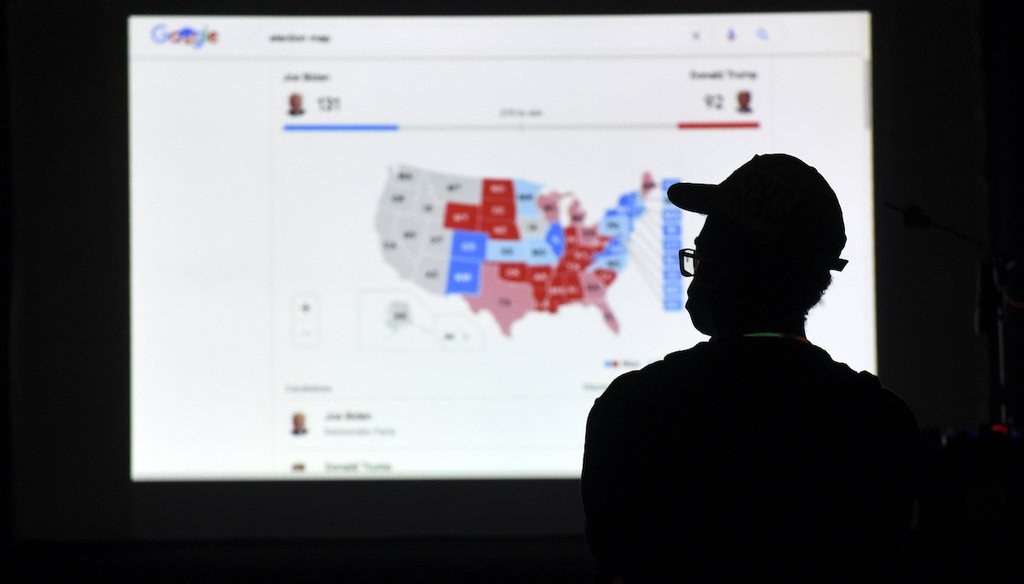Stand up for the facts!
Our only agenda is to publish the truth so you can be an informed participant in democracy.
We need your help.
I would like to contribute

A man watches results come in on a screen set up at an election night gathering at Independence Mall , Nov. 3, 2020, in Philadelphia. (AP)
If Your Time is short
-
Election winners may not be clear for days, or possibly longer, in close races. Counting mail ballots takes time, and only some states allow election officials to start processing mail ballots before Election Day.
-
Election experts say it’s important to be patient on election night. The pace of the count is not an indicator of fraud.
-
Candidates who are leading early in the count may not be the ultimate winners.
In 2020, it took four days for enough votes to be counted in Pennsylvania for media outlets to declare with confidence that Joe Biden had won the presidential election.
During those days, armed protesters showed up outside Philadelphia’s vote-counting center, and Rudy Giuliani, an ally of then-President Donald Trump, held a press conference outside Four Seasons Total Landscaping to level accusations about voter fraud. Misinformation circulated on social media about "ballot dumps."
However, the pace of the count in Pennsylvania and other states did not signal fraud. Instead, it was a sign of how time-consuming it was to tally a flood of mail ballots, prompted by the pandemic. The coronavirus vaccine was not available then, and many Americans were afraid of catching COVID-19 while standing indoors in lines with lots of strangers, so they turned to mail ballots.
There are a few reasons to hope that the 2022 midterm elections will produce a faster count than 2020 did.
Mail ballots, which tend to take longer to count, may not be used to the extent they were in 2020. That year, about 43% of voters cast their ballots by mail. Now, people have resumed many activities indoors. Overall, there’s less fear surrounding COVID-19, given the availability of vaccines and therapeutics and given that many people have gotten sick with COVID-19 and recovered.
Also, this year is a midterm election, and voter turnout for midterms tends to be significantly lower than for presidential elections.
Finally, election officials have learned something about running elections amid a pandemic.
"Election officials have already gone through an election cycle with increased mail balloting," said Rick Klein, the political director for ABC News. "So it won’t be the first time for them."
Still, a big lesson of 2020 voting — being patient — will be important this year, too.
Political journalists told PolitiFact they plan to be cautious about how they report the results and are emphasizing not just who they’re declaring as the projected winner, but why.
Voting advocates and elections experts are also warning Americans to watch out for misinformation. Allegations of voter fraud are likely to crop up as people wait for ballots to be counted or as small logistical errors happen, said Rachel Orey, associate director of the elections project at the Bipartisan Policy Center.
Americans may not know on election night which party will control the House or Senate in 2023, if the results are close in multiple states with hot congressional races. It might take days, or longer, to count enough ballots to know with reasonable certainty the outcome of key races, said Joe Lenski, co-founder and executive vice president of Edison Research, which conducts exit polls for major networks.
People shouldn’t think of "election night" anymore, rather "election week." And it could last even longer if the closely watched Georgia Senate race produces a runoff, which would occur if neither Democratic incumbent Raphael Warnock nor his Republican challenger, Herschel Walker, receives over 50% on Nov. 8. The runoff would be held Dec. 6. That race could determine control of the Senate, similar to two Georgia runoffs in January 2021.
"The public needs to be patient, but we also have to acknowledge that part of the problem rests with the public fretting over gaining resolution to close elections," Massachusetts Institute of Technology political scientist Charles Stewart said.
Challenges that could affect the timing of results
Counting of mail ballots: No state posts mail ballot results before the polls close. But some states allow election officials to begin processing mail ballots before Election Day. That means they can verify that the ballot was submitted by a valid voter, including checking signatures and often removing the ballot from the inner security envelope.
Other states are more strict. For instance, in Pennsylvania, election workers can’t start processing mail ballots until 7 a.m on Election Day.
Twenty-six states permit the scanning of ballots into tabulators before Election Day, according to the Bipartisan Policy Center.
In Michigan, state lawmakers recently approved legislation giving clerks in municipalities with at least 10,000 residents two days to preprocess absentee ballots (which can be returned by mail, at a drop box or in person). Democratic Gov. Gretchen Whitmer still has to sign the bill into law.
Some states, including Arizona, have for decades offered mail ballots to any voter who wants one and have well-developed policies for handling them. But other states are newer to the process.
Pennsylvania since 2019 doesn’t require an excuse for voting by mail. But the state is unable to provide results instantly because it doesn’t have enough people and other resources to handle the process, said Khalif Ali, executive director of Common Cause in Pennsylvania, a group supporting voting rights.
In Georgia, state lawmakers passed a law in 2021 intended to accelerate vote counting, said Stephen Fowler, a reporter for Georgia Public Broadcasting. Local election officials can start removing ballots from envelopes, but not tabulate results, about two weeks before Election Day.
By 10 p.m. on election night, local officials must report the total number of votes cast in person and the number of absentee ballots received by the deadline. That will provide the public with a total number of ballots cast — but not necessarily an answer on the outcome. Officials have until 5 p.m the day after the election to report the absentee ballot results.
How results are transmitted can also affect when unofficial results are available. For instance, in Michigan, election workers and officials in most counties now have to take thumb drives with the results data from polling locations and counting boards that tabulate absentee ballots to election offices that then upload them online.
"It just delays everything," said Harrison Township Clerk Adam Wit, who serves as president of the Michigan Association of Municipal Clerks.
Varying levels of experience among election workers: Since 2020, election officials have faced an increase of violent threats, prompting some to quit and be replaced by workers with less experience.
Different ways of processing ballots: Larger jurisdictions that use machines to speed ballot processing may have results sooner than jurisdictions that rely on people to manually remove ballots from envelopes.
"Consider when you get your mail and how long it takes to open each envelope. Extrapolating that to hundreds, thousands, even millions of envelopes. It takes time," said Tammy Patrick, an elections expert at the Democracy Fund, a group that gives grants to entities that support democracy work. (PolitiFact received a grant in 2016).
Voting methods that take more time: Alaska has often been one of the last states to finish counting ballots, and that is expected to be the same this year now that the state has implemented ranked choice voting.
Alaska voters will rank their preferences in U.S. House and Senate races. Election officials will announce voters’ first choices on election night, Nov. 8, but won’t tabulate the second round until Nov. 23.
California, Oregon and Washington conduct elections primarily by mail ballot. So the counting of those ballots will likely take time. "In California, 50% to 60% of the vote comes in after election day," said John Couvillon, a Louisiana-based pollster and political analyst.
Tips to remember as you watch election results
Candidates who are leading early in the count may not be the ultimate winners: In 2020, Trump enjoyed a lead of more than 100,000 votes in Wisconsin early in the night, but the picture quickly shifted after the city of Milwaukee’s central count finished processing mail-in votes around 3:30 a.m local time. The late boost for Biden from Milwaukee was expected, especially because mail-in ballots tend to skew toward Democrats in Wisconsin.
Be aware of claims on social media: In 2020, we saw a deluge of falsehoods as battleground states were tabulating results.
Results reported by the media are unofficial: Media outlets make calls about the projected winner when a state has counted a sufficient number of ballots. These calls are based on unofficial results, and may not include all ballots cast.
The Associated Press is one of the key news outlets that calls the winners of races. Anna Johnson, the AP’s Washington, D.C., bureau chief, told PolitiFact that the organization is emphasizing "explanatory coverage of key race calls the AP will make."
Read this story in Spanish.
RELATED: Political Extremism in the Public Square: A resource for journalists and voters
RELATED: Midterm elections: What does history say? And what could make 2022 different?
RELATED: Before election, Michigan Republicans blast Secretary of State Benson for her oversight of last on
Our Sources
National Conference of State Legislatures, Table 16: When Absentee/Mail Ballot Processing and Counting Can Begin, May 17, 2022
U.S. Census Bureau, Majority of Voters Used Nontraditional Methods to Cast Ballots in 2020, April 29, 2021
AP, Voter challenges, records requests swamp election offices, including in Florida; In northern Florida, two residents challenged the registrations of nearly 2,000 voters just six days before last month's primary. Sept. 17, 2022
New York Times, Using Hurricane Sandy as a Lesson for Future Elections, Nov. 12, 2013
Detroit Free Press, "Michigan election officials demanded change after 2020. Their calls so far have gone unmet.," Jul. 5, 2022
Detroit Free Press, "Lawmakers pass series of election bills following negotiations on preprocessing ballots," Sept. 28, 2022
Detroit Free Press, "Michigan clerks ask lawmakers for early voting, other changes ahead of 2022 elections," Feb. 28, 2022
Michigan Association of Municipal Clerks and Michigan Association of County Clerks, An Open Letter to Michigan’s State and Legislative Leaders, Feb. 28, 2022
Detroit Free Press, "Election totals come in slowly in Wayne County following change in transmitting results," Aug. 3, 2022
Detroit News, "Michigan changed how election results get reported. Expect more delays in November," Aug. 8, 2022
U.S. Election Assistance Commission, Voluntary Voting System Guidelines 2.0, Feb. 10, 2021
Michigan Secretary of State’s Office, 2022 Michigan Election Voter Turnout, accessed Sept. 19, 2022
WHYY, Biden wins presidency with key victory in Pennsylvania, Nov. 7, 2020
Rev.com, Rudy Giuliani Trump campaign Philadelphia press conference at Four Seasons Total Landscaping, Nov. 7, 2020
USA Today, Giuliani holds press conference at landscaping business, prompting confusion, Nov. 7, 2020
Bipartisan Policy Center, From Examination to Tabulation, September 2022
Bipartisan Policy Center, Mail Voting is Safe and Secure, Aug. 26, 2022
Georgia laws, SB202, 2021
Georgia Public Radio, What Does Georgia's New Voting Law SB 202 Do? March 27, 2021
Georgia Public Radio, Georgia Election Board Extends Emergency Rules For Absentee Voting, Nov. 23, 2020
PolitiFact, No, President Trump, ‘ballot dumps’ in key states were not a magical surprise, Nov. 4, 2020
PolitiFact, Battleground states did not ‘stop counting’ votes on election night when Trump was ahead, Nov. 4, 2020
PolitiFact, No, Wisconsin did not take a break from counting election results, Nov. 5, 2020
PolitiFact, No evidence Dominion Voting Systems caused widespread tabulation errors that flipped votes for Biden, Nov. 13, 2020
PolitiFact, Most states don’t explicitly ban guns at polls. Some lawmakers want to change that, March 31, 2022
PolitiFact, How will social media platforms respond to election misinformation? It isn’t clear, Aug. 1, 2022
Email interview with Charles Stewart, MIT political scientist, Sept. 15, 2022
Email interview with Rachel Orey, associate director of the voting rights project at the Bipartisan Policy Center, Sept. 22, 2022
Email interview with Nick Custodio, Philadelphia deputy commissioner, Sept. 16, 2022
Email interview with Tammy Patrick, elections specialist at the Democracy Fund, Sept. 22, 2022
Interview with Jay Heck, executive director of Common Cause Wisconsin, Sept. 19, 2022
Interview with Khalif Ali, executive director of Common Case Pennsylvania, Sept. 16, 2022
Email interview with Lisa Williams, spokesperson for the Wayne County, Mich., clerk’s office, Aug. 3-5, 2022
Email interview with Tracy Wimmer, former spokesperson for Michigan Secretary of State’s Office, Aug. 3, 2022
Interview with Adam Wit, Harrison Township Clerk and president of the Michigan Association of Municipal Clerks, Sept. 16, 2022
Email interview with Jake Rollow, spokesperson for the Michigan Secretary of State’s office, Sept. 15-16, 2022
Email interview with Kyle Kondik, managing editor of Sabato's Crystal Ball at the University of Virginia Center for Politics, Sept. 19, 2022
Email interview with Joe Lenski, co-founder and executive vice president of Edison Research, which conducts exit polls for major networks, Sept. 28, 2022
Email interview with Anna Johnson, Associated Press Washington Bureau Chief, Sept. 22, 2022
Interview with John Couvillon, Louisiana pollster and political analyst, Sept. 19, 2022
Interview with Rick Klein, political director at ABC News, Sept. 23, 2022
Interview with Stephen Fowler, Georgia public radio reporter, Sept. 28, 2022


















































